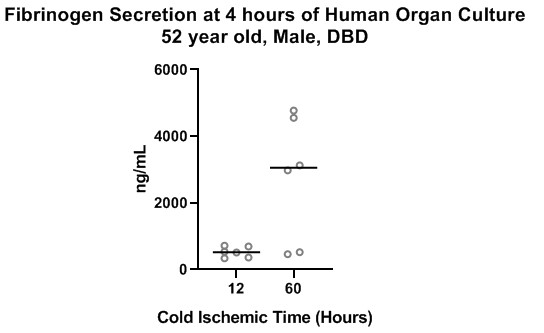Human Organ Culture: A Novel Method for Evaluation of Reperfusion Injury in Human Kidney
1Department of Surgery, Yale School of Medicine, New Haven, CT, 2Department of Biomedical Engineering, Yale University, New Haven, CT, 3Department of Surgery, University of Cambridge, Cambridge, United Kingdom, 4Department of Immunobiology, Yale School of Medicine, New Haven, CT
Meeting: 2020 American Transplant Congress
Abstract number: A-366
Keywords: Cadaveric organs, Ischemia, Kidney transplantation, Resource utilization
Session Information
Session Name: Poster Session A: Ischemia Reperfusion & Organ Rehabilitation
Session Type: Poster Session
Date: Saturday, May 30, 2020
Session Time: 3:15pm-4:00pm
 Presentation Time: 3:30pm-4:00pm
Presentation Time: 3:30pm-4:00pm
Location: Virtual
*Purpose: Evaluate the ability of human organ culture to assess protein secretion during a model of reperfusion injury.
*Methods: Biopsies are obtained from transplanted-declined human kidneys after specific cold storage times. These biopsies are then dissected into 1mm^3 samples and placed in culture media (without fetal bovine serum) for incubation at 37°C. Cultured media and tissue samples are then collected at specific time points during the 37°C incubation period. Fibrinogen content in the media was evaluated by ELISA as an example of secreted protein.
*Results: Ischemia reperfusion injury remains a critical determinant of graft function in renal transplant. It is a determinant in both delayed graft function and graft rejection. The underlying pathophysiology of this injury mechanism is still being understood. Currently we are limited to biopsies from kidneys during transplantation. This severely restricts the sample size with usually only one experiment per biopsy. We hypothesized that human organ culture (HOC) could be used to simulate the function of renal cells during reperfusion injury. HOC has the advantage of using extremely small pieces of tissue so one biopsy can be evaluated in multiple conditions. We recently discovered fibrinogen is synthesized during cold ischemia and secreted during normothermic perfusion (manuscript in review). We demonstrated increasing levels of fibrinogen secretion into media at 1, 2 and 4 hours of incubation. We also demonstrated higher levels of fibrinogen at longer cold ischemic times.
*Conclusions: HOC allows small samples of tissue to potentially function as they would during reperfusion. Using this technique we were able to replicate known effects of fibrinogen production during cold ischemia and secretion in a normothermic setting. We will be able to expand this assay to look for other products of reperfusion injury and test therapeutics such as small molecule drug inhibitors as well.
To cite this abstract in AMA style:
Langford JT, Edwards C, DiRito J, Harris M, Hosgood SA, Nicholson ML, Pober JS, Haakinson D, Tietjen GT. Human Organ Culture: A Novel Method for Evaluation of Reperfusion Injury in Human Kidney [abstract]. Am J Transplant. 2020; 20 (suppl 3). https://atcmeetingabstracts.com/abstract/human-organ-culture-a-novel-method-for-evaluation-of-reperfusion-injury-in-human-kidney/. Accessed December 30, 2025.« Back to 2020 American Transplant Congress


